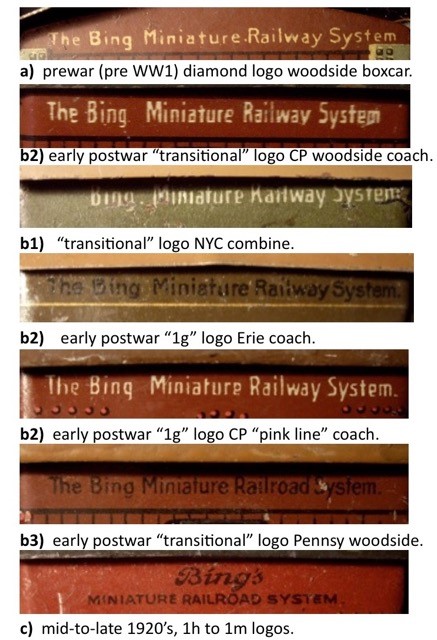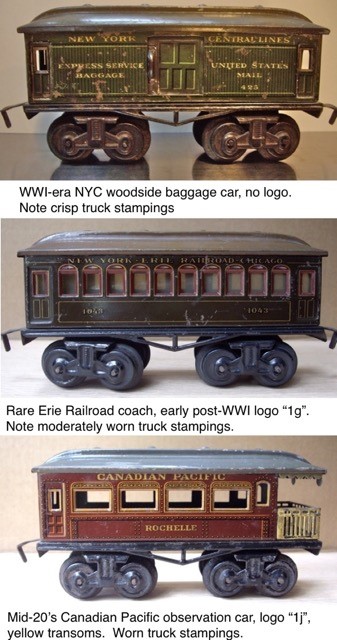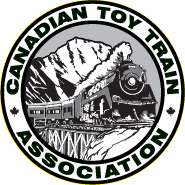Sequencing Bing trademarks for Canada and the USA
By Charles Reif, CTTA, TCA
Introduction:
The Bing toy company was founded in 1863 in Nurnberg, Germany by brothers Ignaz and Adolf Bing. By 1914, the company had grown to near 5,000 employees. At first, toy trains for America were just European locos with a bell and cowcatcher added on. Then in 1910 Bing began a line of cast iron American outline locomotives and tin lithographed cars in 0 gauge and 1 gauge, named for the Pennsylvania and New York Central railroads, in direct competition with Ives. Over time, Bing added Canadian Pacific, Erie and Chicago Milwaukee & St. Paul to its line. While some models were discontinued, much of Bing’s product line continued to be sold in North America until the company went out of business in 1932.
Dating by Catalog, Lithography & Trade Marks:
The focus of this article will be on the BING trademarks typically found on the bottom of passenger and freight cars, and how they may be used in conjunction with lithographic details on the car bodies to suggest a sequence of production. [See Chart below.] Catalog information and the examination of trucks and wheels can also assist in dating Bing trains.
Catalogs:
BING’s Own Catalogs: Historians of Gebruder Bing and Bing Werke are fortunate to have access to reprints of a couple of old Bing American catalogs, where Bing’s own product reference numbers can be noted.
Department Store Catalogs: An excellent source of information for tracking American BING products through time, especially Sears Roebuck and Montgomery Ward, and to a lesser extent the catalogs of distributors such as Butler Brothers. The only reference material found so far for Bing Canadian Pacific trains are the sets appearing in the Eaton’s Department Store catalogs of 1925-26 through 1931-32, which are all windup sets. For the most part, the top line sets simply did not sell in high enough volume to warrant catalog placement.
Litho:
Litho detail variations can help to date pieces, and in particular the form of lettering across the top of the ends of lithographed passenger cars — see photos at right. The type of car and style of trademark logo are given for each lettering type shown.

Type a) pre-WWI version, “The Bing Miniature Railway System”
Type b) immediate post-WWI, either
1. “Bing Miniature Railway System” or
2. “The Bing Miniature Railway System” or3. “The Bing Miniature Railroad System”
Type c) by the mid-20s, it became “Bing’s Miniature Railroad System” and remained so until the end of production.
Some passenger car versions have no identifying lettering on the ends. Some freight cars have only “gbn” on the ends.
Comparison of letter styles and logos raises many questions. For example, why are b1 , b2 and b3 lettering types all found with transitional logos? Which came first? How long was the transitional logo used? The variety of trademark logo styles are described below.
Trucks and wheels:
Rough dating can be made by viewing the degree of dye wear on truck stampings. Prewar trucks have sharp detail, with progressive loss of detail post-WWI. Nickel wheels (vs. black-finished wheels) appear to be a late 20s variation.

Trade Marks:
Trade marks were stamped on motor parts, and especially the bottom of freight and passenger cars. Bing product for export was required by the laws of importing nations to add various origin wordings at various times. A trial run at sequencing these marks is described below [and refer to Chart farther below].
Bing’s embossed pre-WWI ‘GBN-inside-diamond’ trademark is well known [fig. 1a]. When a strong U.S. import law was established in 1909, an embossed “BAVARIA” was added [fig. 1b]. At roughly the same time, a slightly different diamond logo was augmented with a red rubber-stamped “MADE IN GERMANY” [fig. 1c], and then “GERMANY” embossed under the diamond [fig. 1d].
[Note that the diamond in 1a and 1b differs slightly from the diamond in 1c and 1d. The reason for two versions is unknown to us, nor the reason for the prewar designations of “BAVARIA” vs. “GERMANY”.]
A number of pieces lack any logo (embossed or otherwise) [fig 1e]. These pieces sometimes also lack any Bing System lettering on the ends, often lack any identification, or at most a subtle “GBN” on the lower end litho. Some people have speculated that these pieces were made early in the WWI period (1914-16), prior to U. S. entry into the war, with no trademark in an attempt to avoid recognition as a German import. Bing ceased all wartime toy production before 1917.
In 1919, after the death of Ignaz Bing, the company became Bing Werke AG, with a new BW logo. The first embossed form, for continuity, had a small version of the prewar diamond over top of the new BW, with the words “MADE IN BAVARIA” beneath [fig 1f]. This transitional logo appeared on Bing corporate documents as late as 1925. But by the early 1920’s the diamond seems to have been dropped from embossed logos, and the B and W thickened [fig 1g]. Both the 1f and 1gforms have thicker lettering than later logos, with vertical ribbing apparent on the letters.
A slightly later form has a thinner B and W, with the words “TRADE MARK” above, and “BAVARIA” below [fig 1h]. Subsequently, the words “TRADE MARK” are omitted[fig 1i], and then in the mid-20S, “GERMANY” replaces “BAVARIA” under the BW [fig 1j].
The order of 1h and 1i is not certain, but “GERMANY” will replace “BAVARIA” from mid-20s onward.
The last logo form, seen on what appear to be the post-1925 pieces, has the wording “INT. REG. TRADE MARK” above the BW, and “MADE IN GERMANY” below[fig 1k]. In a later form of this logo, the B and W themselves are flattened out [fig 1l].
This last logo form has been found metal-embossed and also rubber stamped in yellow [fig 1m].
Figure 1: A. PRE WWI

1a. prewar logo type 1*, embossed, 1903 – 1919 (Schiffmann)
529 Pennsy 5.5” 4 wheel woodside observation. [“MADE IN BAVARIA” rear wall obsv. deck] [*not Bing’s first logo, but the first seen on post-1909 lithographed North American lines.]
1b. prewar export logo type 1, embossed “BAVARIA”. 1910 — 1916 (1917?) 5.5” 4 wheel woodside CP Rochelle coach. large 3 axle type tender, with 30-2 cast iron clockwork steam loco (came with CP BW cars).
1c. prewar logo type 2*, rubber stamped “MADE IN GERMANY”. (1910 — ?) 501 Pennsy 5.5” 4 wheel woodside baggage. [no end lettering on body] [*logo type 1 has corner discs projecting beyond the diamond, while logo type 2 has corner discs that stay within the diamond.]
1d. prewar logo type 2, embossed “GERMANY”. (1910 — ?) 8 wheel boxcars: Erie, NYCHR, CP 70202 outside braced, CP 96744.
1e. no logo, 1914-18…? 1917-18…? 8 wheel frt. cars: B&O, CNJ, CP 96744 boxcars, 263 CP caboose: 6.5” 4 wheel CP Parkville coach and Rochelle observation; pair CP Rochelle 4.5” coaches, [litho “63” on end]; set of CP 5.5” bag/coach/obsv [litho “67” on end].
B. POST-WWI:
1f. transition logo, GBN over BW (deep B), “MADE IN BAVARIA”, 1919 — ?* 501 Pennsy 5.5” 4 wheel woodside baggage [“MADE IN BAVARIA” on ends]; 617 Pennsy 5.5” 4 wheel woodside coach [”The Bing Miniature Railroad System” on coach ends.]; 2395 NYC 6.5” 8 wheel combination car [“Bing Miniature Railway System” on coach ends.]; 4 wheel laughing boy 5.5” beer car, European couplers. [*this logo appeared on Bing corporate documents until as late as 1925 (Schwarz)
1g. early BW logo, heavy lines, “MADE IN BAVARIA”*, 192… — 192…?; “pink line” early 6.5” 8 wheel CP Rochelle coaches; 5.5” 4 wheel woodside CP Rochelle coach; Erie 6.5” 8 wheel coach [* all have “The Bing Miniature Railway System” printed on coach ends.]

1h. BW “TRADE MARK” and “BAVARIA”. (dates?)
2 CP 5.5” 4 wheel 48500 boxcars, 5.5” Old Dutch reefer.*
CM&St. P 4 wheel 5.5” obsv (came in set with 2 Rochelle coaches, loco, etc.)* [* all have “Bing’s Miniature Railroad System”]
1i. BW “BAVARIA”, thin letters, deep B. (dates?) English market 4.25” GWR gondola
1j. BW “GERMANY”, thin letters, flat B. (dates?)
8 wheel frt cars: Swift’s reefer, 41 Pennsy caboose, 263 Pennsy caboose; many CP 8 wheel 6.5” passenger cars (all have black wheels); CP 8 wheel 8” combine (painted baggage doors, black wheels); CP 4 wheel 5.5” 36 caboose.
C. LATE LOGOS:
1k. BW “INT. REG. TRADE MARK”, “MADE IN GERMANY”, deep B. (1926 – 32?), most CP 8 wheel 8” passenger cars (litho baggage doors, all have nickel wheels); CP 4 wheel 5.5” passenger cars (nickel wheels); 8 wheel frt. cars: CP 70202.
1l. BW “INT.REG.TRADE MARK”, “MADE IN GERMANY”*, flat B. (1926 – ?)
4.5” #1000 Peerless Tank Line car; *flat B ”INT.REG.TRADE MARK” plus “BAVARIA” litho’d on end of British market tank car.
1m. BW “INT.REG.TRADE MARK”, “MADE IN GERMANY”, flat B, rubber stamped. (1926 – ?), 7” clockwork bullet-nose tin loco, also on tender, and 5.5” CP pass. cars (boxed set).
I am seeking to date the array of Bing trademarks found on Canadian Pacific and other North American railroad products since around 1910, and establish the earliest CP production date. Assistance appreciated.
In conclusion:
Some key questions for which the author would welcome answers:
1. Were these trade mark logos sequential, as the author believes? Or was there some overlap in their use?
2. Is the sequence correct as shown? Can dates be defined for each logo?
3. At what date did Bing stop stamping the 1f transition logo on its toy products? Its rarity on toy trains suggests that it was replaced in the early 1920s by the BW logos, yet it appears on corporate documents as late as 1925.
References:
Schiffmann Bing Spur 0; Claude Jeanmaire’s Bing Brothers, and Granddad’s Model Railways; Hilly Lazarus’ unpublished review of Canada’s Eatons store catalogs; Keith Wills’ Collectors Consist articles in RMC magazine; Bernard Schwarz’s Bing corporate history; advice and support from many collectors especially Uwe Groll of the Bing Museum in Freinsheim, Germany, with the Swiss and German Bing Experts who reviewed my work, and my west coast collecting colleague Frank Schmidt for sharing his collection and a passion for “Canadian Tin.”
Editor’s note: The original article in PDF as submitted by the author is here to view or download.
